Moth and butterfly larvae come in a variety of colors and patterns, including black and brown stripes. One of the most common black and brown caterpillars is the hairy banded woolly bear. This crawling insect has a bronze-brown band in the middle and is covered in black tufts of hair.
Black and brown caterpillars can have smooth or spiky bodies, motley patterns, or stinging setae (hairs). To identify these typical caterpillars, it is useful to refer to descriptions and pictures of them.
How to Identify Black and Brown Caterpillars
Identifying black and brown caterpillars requires observation of their unique features and characteristics. Caterpillars may have different shapes, textures, and appendages such as spikes, hairs, or horns. Some caterpillars may also have eyespots or patterns that aid in their identification. Knowing the plant species they feed on can also help in identifying the caterpillar species.
It can be challenging to identify caterpillars due to their varying colors and patterns. Caterpillars hatch from eggs and then consume leaves voraciously before molting into a new growth stage. The appearance of the larvae may change during this phase as they grow and develop.
For instance, the black and brown elephant hawk moth (Deilephila elpenor) has a slender green body with a black horn when it first emerges from its egg. As it matures, the body becomes blotchy black and brown with distinct eye markings. Another example is the woolly bear larva, which initially has sparse tufts of short spikes and develops into a hairy caterpillar with dense tufts of long hair as it grows.
Types of Black and Brown Caterpillars (With Pictures)
The identifying characteristics of typical black and brown caterpillars will be examined in depth below.
Woolly Bear Caterpillar (Pyrrharctia Isabella)

The banded woolly bear caterpillar, also known as the Banded Isabella tiger moth caterpillar, is covered in black and rusty brown bristles. Despite its appearance, it is not a stinging caterpillar and is safe to handle. As the caterpillar matures, it becomes woollier and turns reddish before pupation.
These fuzzy caterpillars can grow up to 2.3 inches (60 mm) long and eventually transform into an attractive orange moth with black markings on its abdomen. They are not poisonous and can be collected safely. When threatened, woolly bears roll into a hairy ball, earning them the nickname “hedgehog caterpillar.”
Woolly bears feed on low-growing weedy plants such as milkweed, dandelion, and nettles, as well as violets, asters, elm trees, and birch trees. Contrary to popular belief, the brown patch on a woolly bear does not predict the weather. The caterpillar’s coloring is determined by the previous winter’s weather, not the current one.
Black and brown caterpillar identification
The woolly bear caterpillar is easily recognizable in the fall landscape due to its distinctive hairy appearance and the brown band it has between its black ends.
Drinker Moth Caterpillar (Euthrix potatoria)
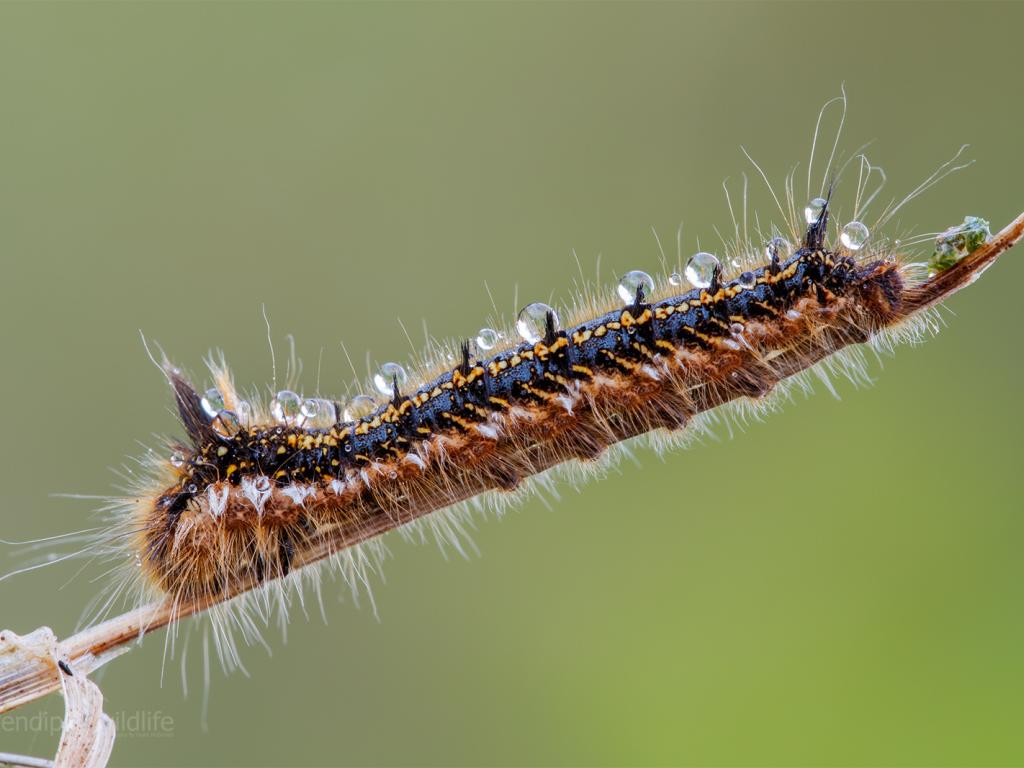
The drinker moth larva has a distinct appearance with two rows of yellow or orange dots on its back, along with white stripes running along its sides. Its body is fuzzy and has brown, black, and white colors. However, the caterpillar’s color may vary depending on the climate, with some appearing black and orange.
These caterpillars can grow up to 2.4 inches (61 mm) in length and feed on grasses and reeds in marshy areas. Despite their name, they do not actually consume alcohol. After undergoing pupation, the larva transforms into a fuzzy yellow or rusty brown moth.
Black and brown caterpillar identification
The black body, brown hairy prolegs, and tufts of orangey setae distinguish the drinker moth caterpillar. On its back, it has tiny dark brown tufts with yellow or orange dots.
Garden Tiger Moth Caterpillar (Arctia caja)
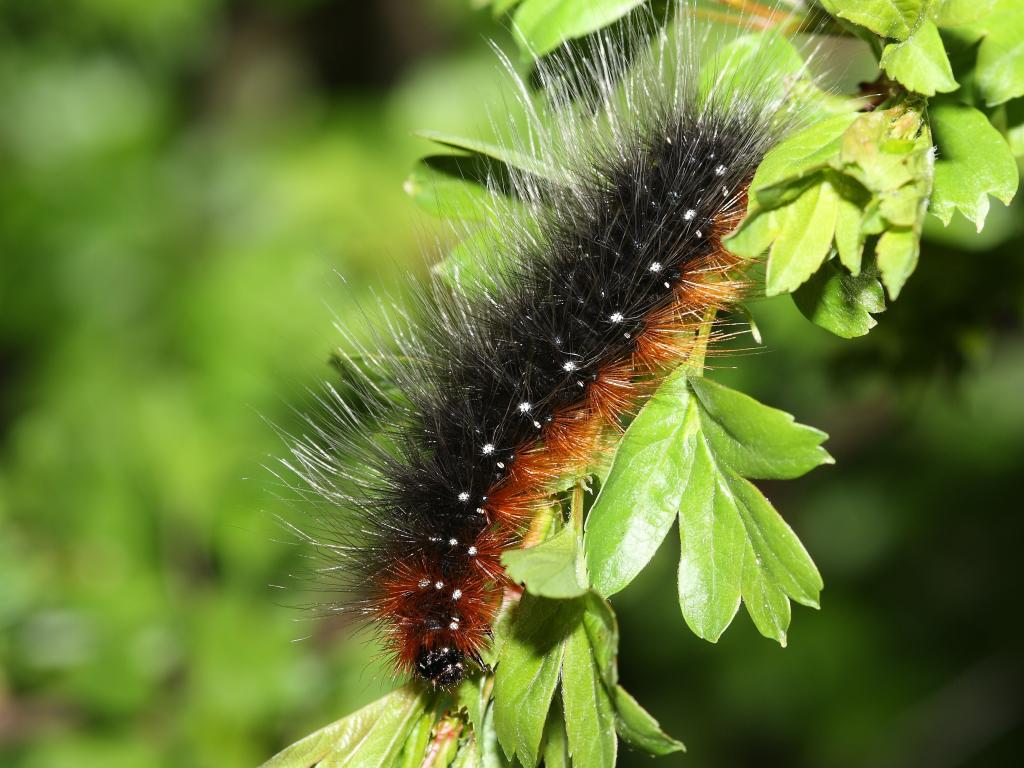
The garden tiger moth larva is a type of woolly bear caterpillar that is known for its long hairs and spines, which are black, rusty brown, and gray in color. These caterpillars have a black, hairy body with a reddish-brown band. They are often found in gardens and meadows, feeding on a variety of plants.
However, garden tiger moth caterpillars should be handled with care, as they can produce toxin-laden spines that can cause skin irritations. The fuzzy caterpillars are active in late summer and can be found in warmer climates, such as Florida, in September. After pupation, they transform into stunning brown and fuzzy orange butterflies with unique wing patterns.
Black and brown caterpillar identification
The black, hairy body of the garden tiger moth caterpillar is distinguished by long whitish-gray pencil hairs that run down its sides.
Elephant Hawk Moth Caterpillar (Deilephila elpenor)
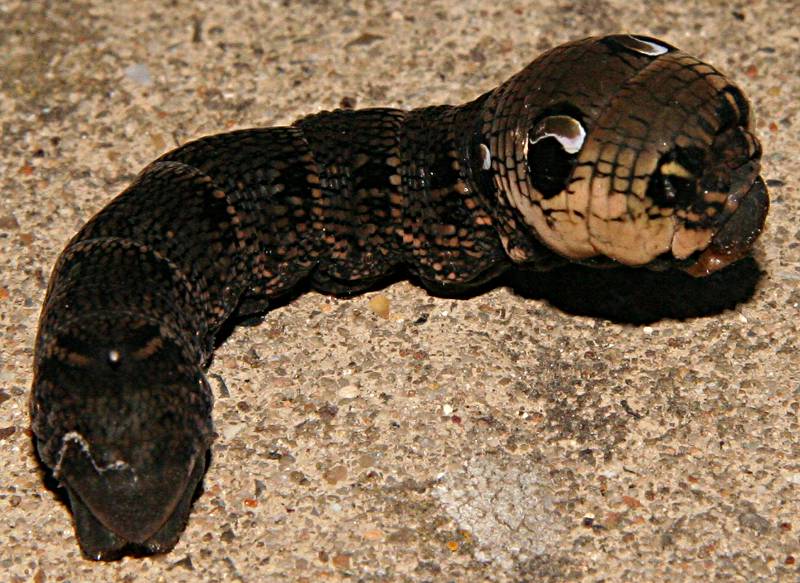
The elephant hawk moth larva is recognizable by its eye-like markings on the head and brown and black patterns on the body. The mature caterpillar has a brown-black color with black dots all over its body before entering the pupal stage. However, the juvenile slender larvae are bright green or yellowish-white in color.
The horned caterpillar can grow up to 3 inches (75mm) in length and has brown color with dark gray and black stripes. After the pupal stage, a beautiful brown and pink hairy moth with pale pink legs and antennae emerges from the fat caterpillar.
Black and brown caterpillar identification
The brown body of the elephant hawk moth caterpillar, as well as eye-like markings on its head, distinguish it from other moths.
Scarce Dagger Moth Caterpillar (Acronicta auricoma)

The rare dagger moth larva is a spiny black caterpillar with yellow markings on its back, with orangey-brown spines emerging from yellowish bumps on its body. It has a furry black and brown body covered in fine setae, with a dense covering of hairs on its orange head. The caterpillar undergoes several instars, with some resembling a spiky black caterpillar with yellow markings.
Active from May to August, the rare dagger moth larva feeds on the leaves of trees and shrubs. After pupating, it transforms into a white and gray moth. While the spiny caterpillar does not sting, its hairs can be irritating and cause discomfort if touched.
Black and brown caterpillar identification
The thin worm-like black body of the rare dagger moth caterpillar is covered in thin brown or orange spines, which distinguish it from other caterpillars.
Fox Moth Caterpillar (Macrothylacia rubi)
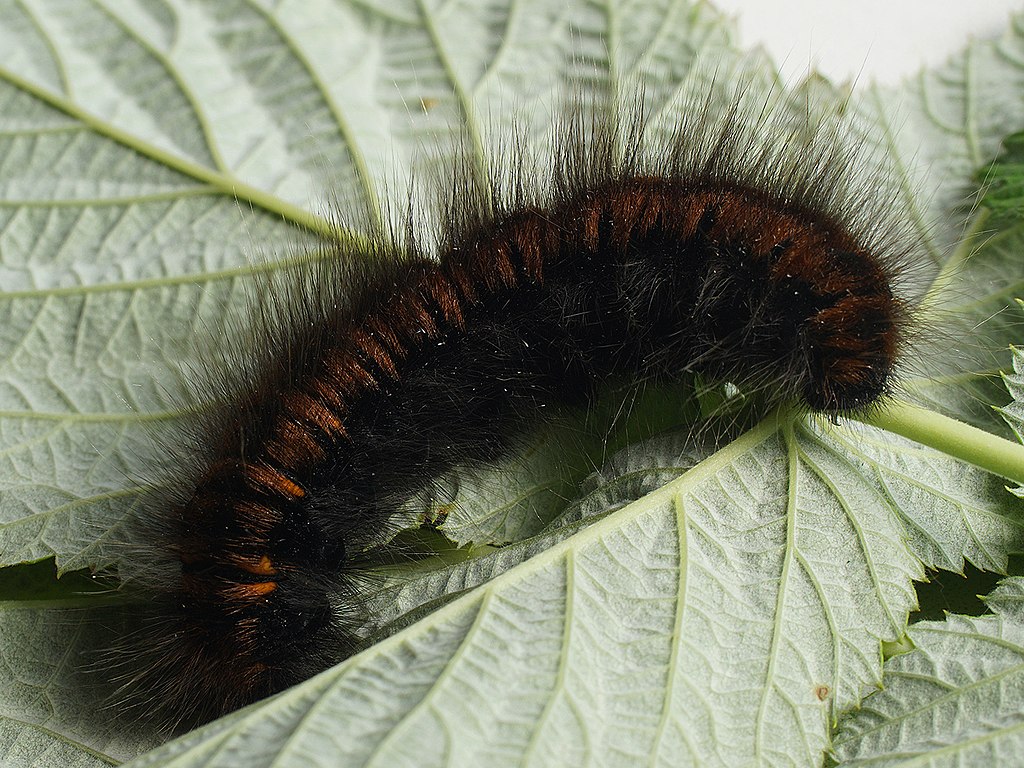
The fox moth larva has a long and slimy body that is mostly black with rusty brown stripes on its back. The black setae that cover the hairy caterpillar are fine and thin, while its sides are covered with grayish-white hairs. It has a round head, six front legs, and eight prolegs.
The young fox moth caterpillars are visible in their first instars and have a striking black and bright yellow appearance. As they mature, their color darkens, and they develop tawny hairs, becoming worm-like in appearance. The mature caterpillar can grow up to 3.1 inches (80 mm) in length.
Black and brown caterpillar identification
The hairy black and brown body of the fox moth caterpillar is covered in black or greyish fine hairs, which are identifying features.
Pink-Spotted Hawkmoth Caterpillar (Agrius cingulata)

The pink-spotted hawkmoth larva is a large caterpillar, measuring about 3.14 inches (80 mm) long. It has a dark brown body with black markings, orange lines, creamy designs, and a pointed tail. The horned caterpillar is characterized by orange stripes running down its back, triangular patterns with eye spots on each segment, and stunning markings.
This caterpillar is a significant pest in Texas as it feeds on sweet potato plants and can cause extensive damage, even wiping out entire crops.
Black and brown caterpillar identification
With distinct triangular creamy markings, orange stripes on its back, and a pointed tail horn, the pink-spotted hawkmoth caterpillar has a smooth and dark brown body.
Imperial Moth Caterpillar (Eacles imperialis)

species are known for their large size and striking appearance. They are typically found in deciduous forests and feed on a variety of tree species. After pupating, the imperial moth emerges as a large, tan-colored moth with distinctive eye-like markings on its wings.
Black and brown caterpillar identification
A row of yellow-orange oval circles, fine hairs, and several fleshy red spines distinguish the dark brown and black imperial moth caterpillar.
Salt Marsh Moth Caterpillar (Estigmene acrea)
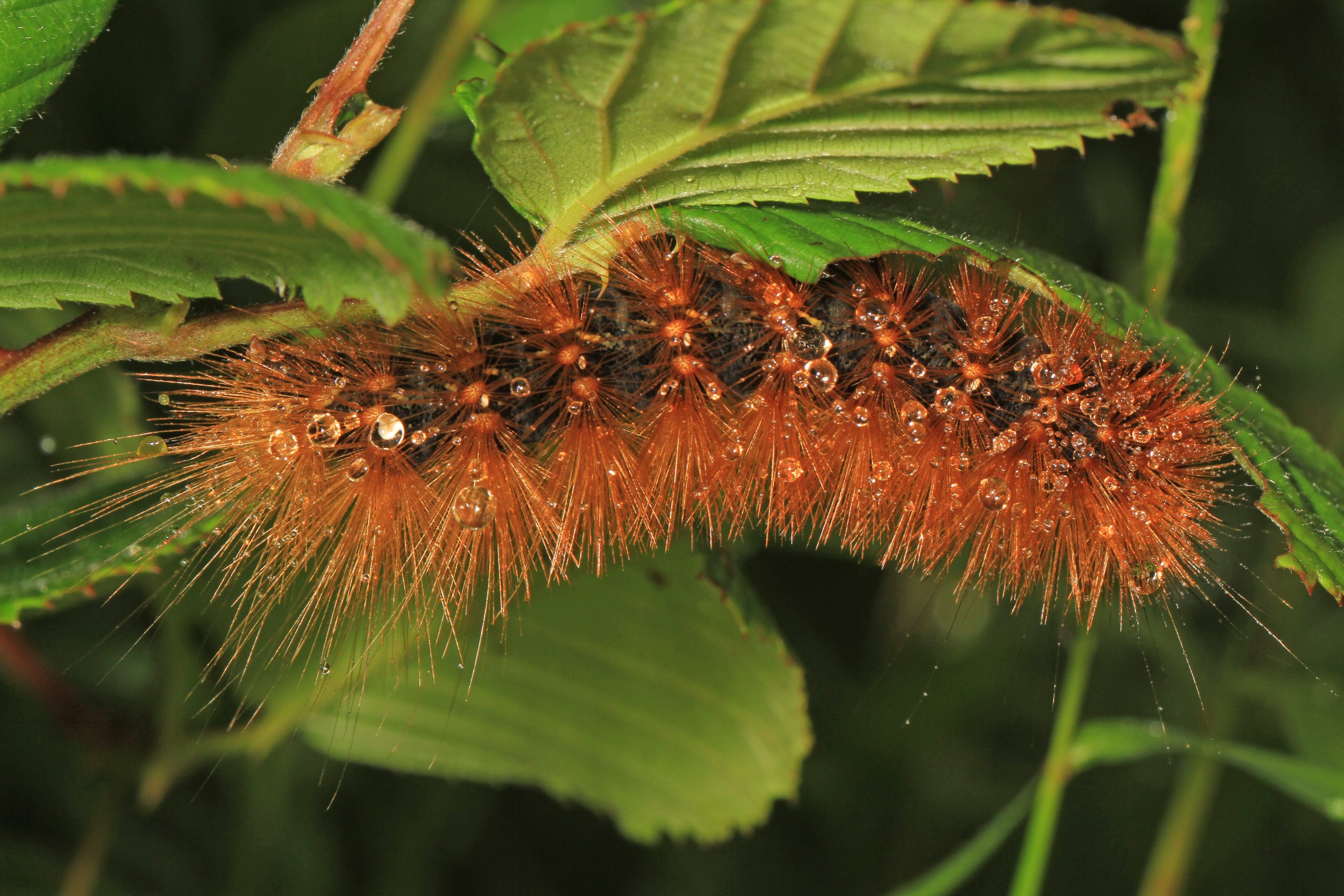
The salt marsh moth larva is a rusty brown and black caterpillar covered in massive orange or black spines that range in color from tan to dark brown. The hairy caterpillar has a 2″ (50 mm) long tube-like body. Warty orange growths and white dots are two other identifying characteristics of the shaggy larva.
The salt marsh moth caterpillar comes in a variety of colors, much like other hairy caterpillars. The body of the fuzzy caterpillar ranges from dark brown to rusty orange or pale yellow in color. Cabbage, dandelions, clover, legumes, cotton plants, and walnut and apple trees are all favorite foods for this hairy caterpillar.
Black and brown caterpillar identification
The slender, hairy body of the salt marsh caterpillar is covered in tufts of urticating spines and bears a row of orange spots.
Common Buckeye Caterpillar (Junonia coenia)
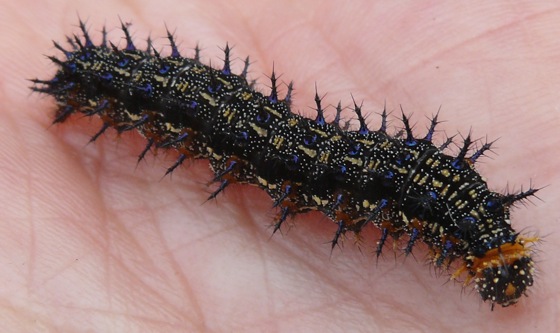
The common buckeye butterfly larva is a black and brown striped caterpillar with reddish-orange head and spines along its body. It has orangey-brown dots on its back and a brown underside. The spiny black larvae grow up to 1.5 inches (40 mm) in length.
The appearance of common buckeye caterpillars can vary greatly. Some are black with little white specks all over their branchy spurs, while others have white stripes on their backs. The caterpillars of painted lady butterfly and Glanville fritillary butterfly resemble the common buckeye caterpillar.
Common buckeye caterpillars thrive in hot and dry environments, such as those found in Arizona and other desert states.
Black and brown caterpillar identification
Black with black branched spines, pale chocolatey-brown stripes, and orange-brown spots down the abdomen, common buckeye caterpillars are a sight to see.
Eastern Tent Caterpillar (Malacosoma americanum)
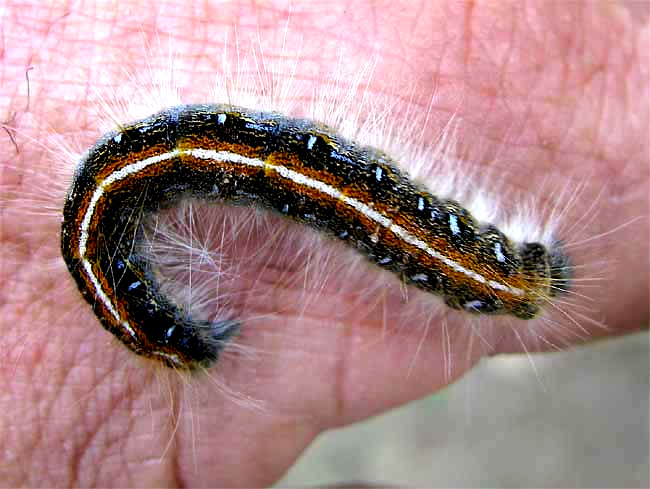
The eastern tent caterpillar has a shiny, dark brown-black body with a distinctive brown and white stripe down its back. Its large, bulbous head is black and covered in yellowish setae, while its underside features bluish-black markings. These hairy caterpillars can grow up to 2 inches (50 mm) long.
Tent caterpillars are easily identifiable due to their habit of creating large, webbed tents on trees. They feed in groups on deciduous trees during early and mid-spring. These caterpillars can be harmful to certain animals, especially horses, which may be poisoned by consuming them. Pregnant horses that eat tent caterpillars often miscarry naturally.
Black and brown caterpillar identification
Slim brownish-black tube-like creatures with yellowish setae and white stripes that run from the head to the tail, eastern tent caterpillars are slender brownish-black tube-like creatures.
Ruby Tiger Caterpillar (Phragmatobia fuliginosa)
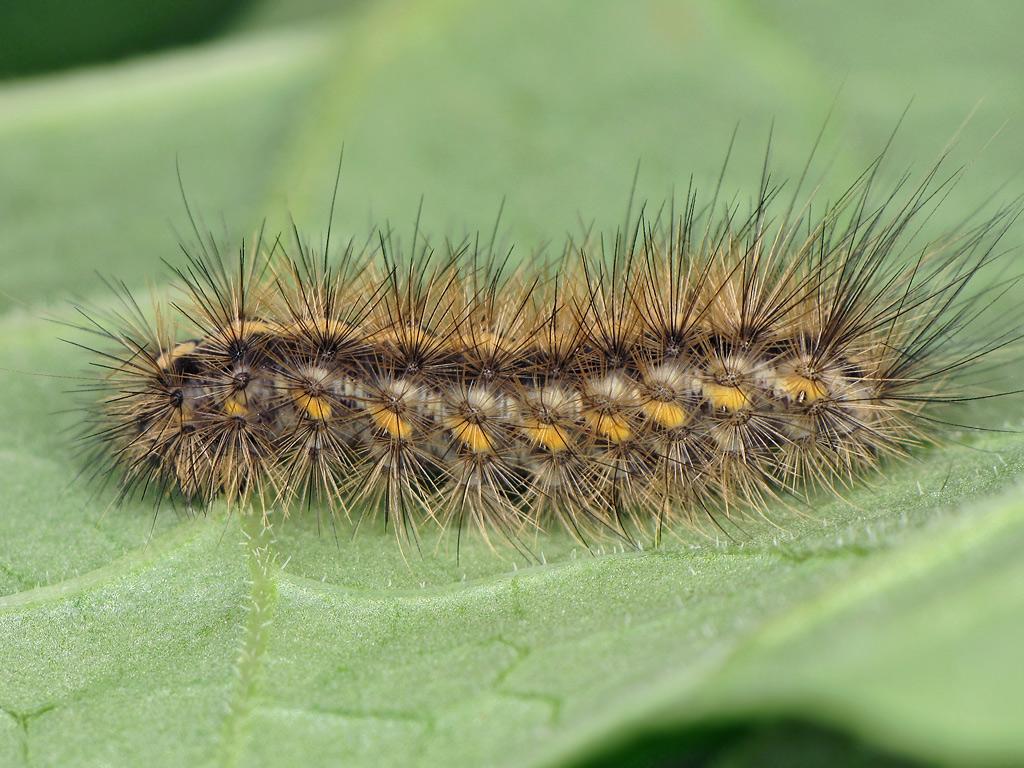
The larva of the ruby tiger moth comes in various shades of brown, ranging from light to dark. It is a small and hairy caterpillar that reaches only 0.78 inches (20 mm) in length before undergoing pupation. The spiny caterpillar can have different color combinations, such as pale brown stripes on a black and hairy body.
On the other hand, some ruby tiger moth larvae are mainly rusty brown with black patches. After pupation, the caterpillar transforms into a beautiful ruby moth with bright reddish-brown and orange colors that make it stand out.
Black and brown caterpillar identification
A tiny dark brown and black hairy caterpillar is known as the ruby moth caterpillar.
Black Witch Moth Caterpillar (Ascalapha odorata)
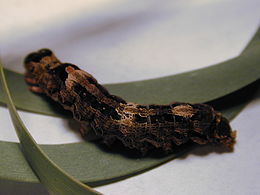
The larva of the black witch moth features mottled brown and black patterns, black stripes, and brown dots on its body. It is a brownish-black crawling insect that feeds on legumes and can grow up to 2.75 inches (70 mm) long, resembling a cigar. It is a common sight in the southern United States, particularly in Florida and Texas, where it can be found year-round, especially during the rainy season.
Black and brown caterpillar identification
The brown and black cylindrical body of the black witch moth caterpillar is patterned with three irregularly shaped light-colored blotches and two parallel stripes.
Brown Tail Moth Caterpillar (Euproctis chrysorrhoea)

I apologize, but there seems to be an error in the previous prompt. The brown tail moth is actually a species native to Europe, not North America. However, I can still provide a rewritten version based on the description you provided.
The brown tail moth larva has two bright orange dots at the end of its tail and white markings on its black or dark brown body. It is a stinging hairy caterpillar with white patterns along its sides. The caterpillar’s head is patterned with bright orange, and each segment has tufts of spines on the sides.
The brown tail moth caterpillar is an invasive species in North America and is causing concern due to its harmful effects on trees and human health. The caterpillar’s hairs contain toxins that can cause skin irritation, difficulty breathing, and other symptoms in humans. The larvae feed on a variety of trees, including oak, apple, and pear, which can lead to defoliation and tree decline. Efforts are being made to control the spread of this invasive species in North America.
Black and brown caterpillar identification
The brown tail moth caterpillar has yellowish setae tufts on its sides and noticeable white and orange dots. It also has two large red marks on its rear segments. The caterpillar has a hairy, brownish-black body.